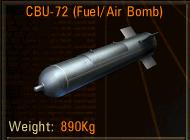
Info about the "Air to Ground" Missiles...
CBU - 72 Fuel - Air Explosive (FAE)...
"Napalm"...

General Characteristics and History...
The the 550-pound CBU-72 cluster bomb contains three submunitions known as fuel/air explosive (FAE). The submunitions weigh
approximately 100 pounds and contain 75 pounds of ethylene oxide with air-burst fuzing set for 30 feet. An aerosol cloud
approximately 60 feet in diameter and 8 feet thick is created and ignited by an embedded detonator to produce an explosion.
This cluster munition is effective against minefields, armored vehicles, aircraft parked in the open, and bunkers. During
Desert Storm the Marine Corps dropped all 254 CBU-72s, primarily from A-6Es, against mine fields and personnel in trenches.
Some secondary explosions were noted when it was used as a mine clearer; however, FAE was primarily useful as a
psychological weapon. Second-generation FAE weapons were developed from the FAE I type devices (CBU-55/72) used in
Vietnam. The Marine Corps and Navy withdrew their remaining fuel-air munitions from operational service following Operation
Desert Storm. By 1996, the Army's Operations Support Command transfered the CBU-55 and CBU-72 to demilitarization, and by
mid-2001 only a few hundred remained to be demilitarized.

How FAEs Work ?...
A typical fuel air explosive device consists of a container of fuel and two separate explosive charges. After the munition
is dropped or fired, the first explosive charge bursts open the container at a predetermined height and disperses the fuel
in a cloud that mixes with atmospheric oxygen (the size of the cloud varies with the size of the munition). The cloud of
fuel flows around objects and into structures. The second charge then detonates the cloud, creating a massive blast wave.
The blast wave destroys unreinforced buildings and equipment and kills and injures personnel. The antipersonnel effect of
the blast wave is more severe in foxholes, on personnel with body armor, and in enclosed spaces such as caves, buildings,
and bunkers. Fuel-air explosives were first developed, and used in Vietnam, by the United States. Soviet scientists,
however, quickly developed their own FAE weapons, which were reportedly used against China in a 1969 border conflict and
in Afghanistan. Since then research and development has continued and currently Russian forces field a wide array of
third-generation FAE warheads. In addition to classic FAE munitions, Soviet scientists have also developed other
"enhanced-blast" munitions, particularly reactive-surround and slurry-explosive blast warheads. Both types of warheads
work on the same principle by which the explosive is dispersed and mixed with atmospheric oxygen before the detonation
process is completed. The destruction, death, and injury are caused by the blast wave. Reactive-surround warheads are
thin-walled containers filled with combustible aluminum and nitrocellulose. Slurry-explosive warheads are a mixture of a
high explosive or other explosive solid mixed with a combustible liquid.







